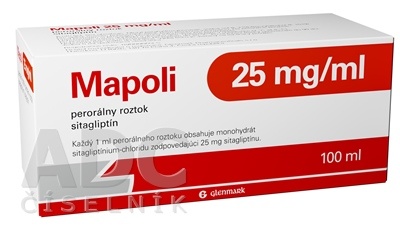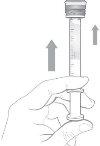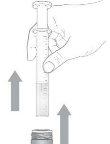

MAPOLI 25mg/ml ORAL SOLUTION

Ask a doctor about a prescription for MAPOLI 25mg/ml ORAL SOLUTION

How to use MAPOLI 25mg/ml ORAL SOLUTION
Introduction
Package Leaflet: Information for the Patient
Mapoli 25 mg/ml Oral Solution EFG
sitagliptin
Read all of this leaflet carefully before you start taking this medicine because it contains important information for you.
- Keep this leaflet, you may need to read it again.
- If you have any further questions, ask your doctor, pharmacist, or nurse.
- This medicine has been prescribed for you only. Do not pass it on to others. It may harm them, even if their signs of illness are the same as yours.
- If you get any side effects, talk to your doctor, pharmacist, or nurse. This includes any possible side effects not listed in this leaflet. See section 4.
Contents of the pack
- What is Mapoli and what is it used for
- What you need to know before you take Mapoli
- How to take Mapoli
- Possible side effects
- Storage of Mapoli
- Contents of the pack and other information
1. What is Mapoli and what is it used for
This medicine contains the active substance sitagliptin, which belongs to a class of medicines called DPP-4 inhibitors (dipeptidyl peptidase-4 inhibitors) that lower blood sugar levels in adult patients with type 2 diabetes mellitus.
This medicine helps to increase the amounts of insulin produced after a meal and decreases the amount of sugar produced by the body.
Your doctor has prescribed this medicine to help lower your blood sugar level, which is too high due to your type 2 diabetes. This medicine can be used alone or in combination with other medicines (insulin, metformin, sulfonylureas, or glitazones) that lower blood sugar levels, which you may already be taking for your diabetes, along with a diet and exercise plan.
What is type 2 diabetes?
Type 2 diabetes is a disease in which the body does not produce enough insulin, and the insulin it produces does not work as well as it should. The body also makes too much sugar. When this happens, sugar (glucose) builds up in the blood. This can lead to serious medical problems, such as heart disease, kidney disease, blindness, and amputation.
2. What you need to know before you take Mapoli
Do not takeMapoli
- if you are allergic to sitagliptin or any of the other ingredients of this medicine (listed in section 6).
Warnings and precautions
There have been reports of pancreatitis (inflammation of the pancreas) in patients taking sitagliptin (see section 4).
If you develop blisters on your skin, it may be a sign of a disease called bullous pemphigoid.
Your doctor may ask you to stop taking this medicine.
Tell your doctor if you have or have had:
- a disease of the pancreas (such as pancreatitis)
- gallstones, alcohol dependence, or very high levels of triglycerides (a type of fat) in your blood. These diseases may increase your risk of developing pancreatitis (see section 4).
- type 1 diabetes mellitus
- diabetic ketoacidosis (a complication of diabetes with high blood sugar levels, rapid weight loss, nausea, or vomiting)
- any past or present kidney problems.
- an allergic reaction to sitagliptin (see section 4).
It is unlikely that this medicine will cause low blood sugar, as it does not work when your blood sugar level is low. However, when this medicine is used in combination with a sulfonylurea or insulin, low blood sugar (hypoglycemia) may occur. Your doctor may reduce the dose of your sulfonylurea or insulin.
Children and adolescents
Children and adolescents under 18 years of age should not take this medicine. It is not effective in children and adolescents between 10 and 17 years of age. It is not known if this medicine is safe and effective when used in children under 10 years of age.
Other medicines and Mapoli
Tell your doctor or pharmacist if you are taking, have recently taken, or might take any other medicines.
Tell your doctor especially if you are taking digoxin (a medicine used to treat irregular heartbeat and other heart problems). It may be necessary to monitor your digoxin blood levels if you take it with this medicine.
Mapoli with food and drinks
This medicine can be taken with or without food.
Pregnancy and breastfeeding
If you are pregnant or breastfeeding, think you may be pregnant, or are planning to have a baby, ask your doctor or pharmacist for advice before taking this medicine.
You should not take this medicine during pregnancy.
It is not known if this medicine passes into breast milk. You should not take this medicine if you are breastfeeding or planning to breastfeed.
Driving and using machines
The effect of this medicine on your ability to drive or use machines is negligible. However, dizziness and drowsiness have been reported, which may affect your ability to drive or use machines.
Taking this medicine in combination with medicines called sulfonylureas or with insulin may cause low blood sugar, which may affect your ability to drive or use machines or work without a safe support.
Mapoli contains sodium benzoate:
It may cause allergic reactions (which may be delayed).
Mapoli contains benzyl alcohol:
Benzyl alcohol (E1519): 0.02 mg per 1 ml. Benzyl alcohol may cause allergic reactions. Ask your doctor or pharmacist for advice if you have liver or kidney disease, or if you are pregnant or breastfeeding. This is because large amounts of benzyl alcohol may build up in your body and may cause side effects (called "metabolic acidosis").
Mapoli contains sodium:
This medicine contains less than 1 mmol of sodium (23 mg) per ml; i.e., it is essentially "sodium-free".
3. How to take Mapoli
Follow exactly the administration instructions of this medicine given by your doctor. In case of doubt, consult your doctor or pharmacist again.
The recommended dose is:
- 100 mg (4 ml of oral solution)
- once a day
- by mouth
If you have kidney problems, your doctor may prescribe lower doses (such as 25 mg or 50 mg).
Your doctor may prescribe this medicine alone or with other medicines that lower blood sugar levels.
Diet and exercise can help your body use blood sugar better. It is important that you follow the diet and exercise recommended by your doctor while taking this medicine.
Method of administration
Please use the supplied oral syringe to administer your specific dose - see the instructions below. The syringe can be used to measure your dose by drawing the liquid up to the correct mark on the syringe.
How to use the oral syringe:
1. | Shake the bottle well, making sure the cap is tightly closed. |
|
2. | Remove the cap. Note: Keep the cap nearby to close the bottle after each use. |
|
3. | Make sure the plastic adapter is inside the neck of the bottle. Note: The adapter should always remain in the bottle. |
|
4. | Take the syringe and check that the plunger is completely down. | |
5. | Hold the bottle upright and insert the oral syringe firmly into the plastic adapter. |
|
6. | Turn the whole bottle with the syringe upside down. |
|
7. | Slowly pull the plunger down to fill the syringe with medicine. Push the plunger all the way up to expel any large air bubbles that may be trapped inside the oral syringe. |
|
8. | Then, slowly pull the plunger down to the volume you need for your dose. |
|
9. | Turn the whole bottle with the syringe back up and remove the syringe from the bottle. |
|
10. | You can now swallow the dose of medicine directly from the oral syringe. Please make sure you are sitting upright, and the plunger should be pushed slowly to allow you to swallow the dose. |
|
11. | Put the child-resistant cap back on after use, leaving the adapter in place. |
|
12. | Cleaning: After use, disassemble the plunger and rinse both the body and the plunger with tap water and clean with a dry, clean paper towel. |
|
If you take more Mapoli than you should
If you take more than the prescribed dose of this medicine, contact your doctor immediately, or call the Toxicology Information Service, telephone 91 562 04 20, indicating the medicine and the amount ingested.
If you forget to take Mapoli
If you have forgotten to take a dose, take it as soon as you remember. If you do not remember until the time of your next dose, skip the missed dose and go back to your regular schedule. Do not take a double dose to make up for forgotten doses.
If you stop taking Mapoli
Keep taking this medicine while your doctor prescribes it for you to continue helping you control your blood sugar level. Do not stop taking this medicine without consulting your doctor first.
If you have any other questions about the use of this medicine, ask your doctor or pharmacist.
4. Possible side effects
Like all medicines, this medicine can cause side effects, although not everybody gets them.
STOP taking this medicine and contact a doctor immediatelyif you notice any of the following serious side effects:
- Severe and persistent abdominal pain (stomach area) that may radiate to the back with or without nausea and vomiting, as these may be signs of pancreatitis.
If you have a severe allergic reaction (frequency not known), including skin rash, hives, blisters on the skin/exfoliative skin, and swelling of the face, lips, tongue, and throat that may cause difficulty breathing or swallowing, stop taking this medicine and call your doctor immediately. Your doctor may prescribe a medicine to treat the allergic reaction and another for diabetes.
Some patients have experienced the following side effects after adding sitagliptin to metformin:
Common (may affect up to 1 in 10 people): low blood sugar, nausea, flatulence, vomiting.
Uncommon (may affect up to 1 in 100 people): stomach pain, diarrhea, constipation, drowsiness.
Some patients have experienced different types of stomach upset when starting the combination of sitagliptin and metformin (classified as common).
Some patients have experienced the following side effects when taking sitagliptin in combination with a sulfonylurea and metformin:
Very common (may affect more than 1 in 10 people): low blood sugar.
Common: constipation.
Some patients have experienced the following side effects when taking sitagliptin and pioglitazone:
Common: flatulence, swelling of hands or feet.
Some patients have experienced the following side effects when taking sitagliptin in combination with pioglitazone and metformin:
Common: swelling of the hands or feet.
Some patients have experienced the following side effects when taking sitagliptin in combination with insulin (with or without metformin):
Common: flu.
Uncommon: dry mouth.
Some patients have experienced the following side effects when taking sitagliptin alone in clinical trials, or during its use after approval alone and/or with other diabetes medicines:
Common: low blood sugar, headache, upper respiratory tract infection, nasal congestion or discharge and sore throat, osteoarthritis, pain in arms or legs.
Uncommon: dizziness, constipation, itching.
Rare: reduced platelet count.
Frequency not known: kidney problems (sometimes requiring dialysis), vomiting, joint pain, muscle pain, back pain, interstitial lung disease, bullous pemphigoid (a type of skin blister).
Reporting of side effects
If you experience any side effects, talk to your doctor, pharmacist, or nurse. This includes any possible side effects not listed in this leaflet. You can also report side effects directly through the Spanish Medicines Surveillance System for Human Use: https://www.notificaram.es. By reporting side effects, you can help provide more information on the safety of this medicine.
5. Storage of Mapoli
Keep this medicine out of the sight and reach of children.
Do not use this medicine after the expiry date which is stated on the blister, on the label of the bottle, and on the carton after EXP. The expiry date is the last day of the month shown.
Store in a refrigerator (between 2°C and 8°C).
After opening, store in a refrigerator (between 2°C and 8°C).
After opening the bottle, the solution can be stored for 90 days.
Discard any remaining medicine 90 days after opening the bottle.
Medicines should not be disposed of via wastewater or household waste. Place the empty packaging and any unused medicine in the SIGRE collection point at your pharmacy. Ask your pharmacist how to dispose of the packaging and any unused medicine. This will help protect the environment.
6. Contents of the pack and other information
Composition of Mapoli
The active substance is sitagliptin. Each ml of oral solution contains sitagliptin hydrochloride monohydrate, equivalent to 25 mg of sitagliptin.
The other ingredients are:
Sodium benzoate (E219), hydroxyethylcellulose (E1525), citric acid (E330), disodium edetate (E385), polysorbate 80 (E433), butylhydroxyanisole (E320), sodium citrate (E331), Polysorb 7477 (which contains sucralose (E955) acesulfame), forest fruit flavor (composed of maltodextrin (E1400), modified starch (E1400-E1500) (derived from potato), lactic acid (E270), benzyl alcohol (E1519), ethanol (E1510), ethyl butyrate, raspberry flavor, propylene glycol (E1520)), purified water.
Appearance and packaging
Mapoli is a turbid and whitish oral solution with a forest fruit flavor. It comes in a type III amber glass bottle with a child-resistant cap and a tamper-evident closure.
The folded cardboard box contains a glass bottle with a cap and a 5 ml oral dosing syringe (with CE marking, CE 0459) graduated with 0.5 ml.
Marketing authorization holder and manufacturer
Marketing authorization holder:
Glenmark Arzneimittel GmbH
Industriestr. 31
82194 Gröbenzell
Germany
Manufacturer:
Labomed Pharmaceutical Company SA
Metaxa Ioanni 84
19441 Kropia
Greece
You can request more information about this medicine by contacting the local representative of the marketing authorization holder:
Glenmark Farmacéutica, S.L.U.
C/ Retama 7, 7th floor
28045 Madrid
Spain
This medicine is authorized in the Member States of the European Economic Area under the following names:
Country | Medicine name |
Slovakia | Mapoli 25 mg/ml peroral solution |
Czech Republic | Mapoli 25 mg/ml oral solution |
Spain | Mapoli 25 mg/ml oral solution EFG |
Date of the last revision of this leaflet: July 2023
Detailed information on this medicine is available on the website of the Spanish Agency for Medicines and Health Products (AEMPS) https://www.aemps.gob.es/

How much does MAPOLI 25mg/ml ORAL SOLUTION cost in Spain ( 2025)?
The average price of MAPOLI 25mg/ml ORAL SOLUTION in December, 2025 is around 23.68 EUR. Prices may vary depending on the region, pharmacy, and whether a prescription is required. Always check with a local pharmacy or online source for the most accurate information.
- Country of registration
- Average pharmacy price23.68 EUR
- Active substance
- Prescription requiredYes
- Manufacturer
- This information is for reference only and does not constitute medical advice. Always consult a licensed doctor before taking any medication. Oladoctor is not responsible for medical decisions based on this content.
- Alternatives to MAPOLI 25mg/ml ORAL SOLUTIONDosage form: TABLET, 100 mgActive substance: sitagliptinManufacturer: Laboratorios Alter S.A.Prescription requiredDosage form: TABLET, 25 mgActive substance: sitagliptinManufacturer: Laboratorios Alter S.A.Prescription requiredDosage form: TABLET, 50 mgActive substance: sitagliptinManufacturer: Laboratorios Alter S.A.Prescription required
Alternatives to MAPOLI 25mg/ml ORAL SOLUTION in other countries
The best alternatives with the same active ingredient and therapeutic effect.
Alternative to MAPOLI 25mg/ml ORAL SOLUTION in Poland
Alternative to MAPOLI 25mg/ml ORAL SOLUTION in Ukraine
Online doctors for MAPOLI 25mg/ml ORAL SOLUTION
Discuss dosage, side effects, interactions, contraindications, and prescription renewal for MAPOLI 25mg/ml ORAL SOLUTION – subject to medical assessment and local rules.





















